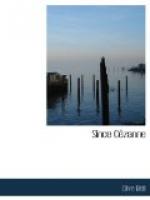Renoir was born in 1841, and in ’54 bound prentice to a china-painter. A fortunate invention deprived him of this means of livelihood and drove him into oil. He escaped early from the Ecole des Beaux-Arts, and, of course, came under the influence of Courbet. By 1863 he was being duly refused at the Salon and howled at by the respectable mob. He thus made one of the famous Salon des Refuses, and has, in consequence, been generally described as an “Impressionist.” It is an honour he neither desires nor deserves. The pure doctrine of Impressionism, as formulated by Claude Monet, enjoins “scientific truth” and submission to Nature, whereas Renoir observed one day to an astonished disciple, “Avec la Nature on ne fait rien”; and on being asked where, then, the student should learn his art added, without any apparent sign of shame or sense of sin—“Au musee, parbleu!”
Renoir thus affirmed what every artist knows, that art is the creation and not the imitation of form. In his eyes the most valuable part of an artist’s education is the intelligent study of what other artists have done. For his own part he studied Courbet and then Delacroix, and, assuredly, from these picked up useful hints for converting sensibility into significant form. Sensibility he never lacked. Renoir’s painting gift may, without unpardonable silliness, be compared with the singing gift of Mozart. His conspicuous characteristics are loveliness and ease. No painter, I suppose, gives more delight, or gives it more frankly. That is why his name provokes an odd, personal enthusiasm in thousands of people who have never seen him. That is why Frenchmen, who have sometimes a terribly intimate way of explaining themselves, have been known to assert that they feel for Renoir the sort of grateful affection that every sensitive man feels for a woman who has given him joy.
But Renoir’s natural masters—parents one would say if a man could have more than two—were Fragonard, Boucher, and Watteau. These, two of whom he has surpassed, with Rubens, whom he almost equals, are responsible for most of what is derivative in his art during his first great period (1870-1881). That this should be the period beloved of amateurs does not surprise me. It is the period of Mme. Maitre (1871), La Loge (1874), Moulin de la Galette (1876), and M. Choquet—“portrait d’un fou par un fou,” Renoir calls it—pictures of ravishing loveliness to set dancing every chord in a spectator of normal sensibility. Also, it is a period that has an extraordinary charm for the literary connoisseur. It throws glamour over the “seventies,” and, for that matter, on to the “eighties.” Here are the characters of Flaubert and Maupassant as we should wish them to be. That dejeuner by the Seine was probably organized by the resourceful Jean de Servigny, and there, sure enough, is Yvette with a fringe. The purest of painters becomes historical by accident. He expresses the unalloyed sensibility of an artist in terms of delicious contemporary life and gives us, adventitiously, romance. A fascinating period, but not the great one.




